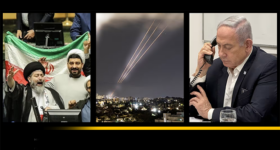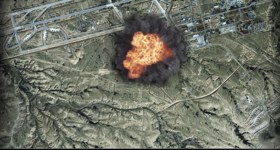
This past weekend, the White House announced it is deploying additional US forces and missile defense systems to the Kingdom of Saudi Arabia and the United Arab Emirates, in response to last week’s attack on the Saudi Aramco‘s oil production facility. Over the past few years, and despite tens of billions in US arms purchases, the Yemeni ‘Houthi’ resistance forces have been able to penetrate further and deeper into Saudi territory and now has proven they can cripple its energy infrastructure with a seemingly rag-tag array of relatively inexpensive missiles and drones.
This has led many defense experts to ask the fundamental question: Does the famed US Patriot Missile defense system actually work as advertised? Can it protect its clients’ valuable assets?
South Front reports…
Missile strikes that shut down a half of Saudi oil production not only marked a new round of escalation in the Persian Gulf, but also revealed the limitations of the Kingdom’s air defense. Over the past years, Saudi Arabia, the state with the third largest military budget in the world ($82.9bn), has spent billions of dollars building up six battalions of US-made Patriot surface-to-air missiles and associated radars. However, these seemingly sophisticated air-defense systems appeared to be not enough to protect key infrastructure objects.
Yemen’s Ansar Allah movement (more widely described by the media as the Houthis) claimed responsibility for the September 14 attack. According to Ansar Allah, its forces employed Qasef-3 and Samad-3 unmanned aerial vehicles, as well as some mysterious “jet-powered unmanned aerial vehicles”, launched from three different positions. The movement added that the strike was a response to the Saudi aggression against Yemen and warned of more strikes to come.
Saudi Arabia and the United States are putting a different version forward, claiming that the strike did not originate from Yemen and was carried out with Iranian-made drones and cruise missiles. The Saudi military explained the air-defense failure by claiming that drones and missiles came from the northern direction, while its air defense radars were oriented towards Yemen in the south. Saudi Arabia and the US are yet to state directly that the supposed strike was launched from Iranian territory, but mainstream media outlets are already speculating on this topic using their lovely anonymous sources.
US Secretary of State Mike Pompeo rushed to defend the reputation of the Patriot system.
“Look, anytime – we’ve seen air defense systems all around the world have mixed success. Some of the finest in the world don’t always pick things up. We want to work to make sure that infrastructure and resources are put in place such that attacks like this would be less successful than this one appears to have been. That’s certainly the case,” Pompeo said during a visit to Saudi Arabia.
However, the truth is that this was not the first time that Saudi Arabia’s Patriots have failed. Over the past years, Ansar Allah has carried out dozens of successful drone and missile strikes on Saudi Arabia, targeting airports, military camps, oil infrastructure and even the Saudi capital, Riyadh. All these attacks were delivered from the ‘right direction’, but this did not help Saudi Arabia to repel them with anything that could be described as a high degree of success.
Multiple incidents involving Patriot missiles failing, malfunctioning or even returning to explode near the launch area do not add credibility to the Saudi Air Defense Forces and their Patriots. One of the most widely covered of such incidents happened on March 25, 2018, when at least 5 Patriot missiles missed, malfunctioned or exploded mid-air during the Saudi attempt to repel an Ansar Allah missile strike.
The repeated failures of Patriots to defend targets in Saudi Arabia already turned them into a meme at an international level.
It also should be noted that the Patriot was originally created to shoot down aircraft, not missiles or drones. The Patriot got the ballistic missile capability after the missile and system upgrade dubbed the PAC-2. This included the optimization of radar search algorithms, the beam protocol in “theatre ballistic missile search”, and the introduction of the PAC-2 missile optimized for ballistic missile engagements. The missile got larger projectiles in its blast-fragmentation warhead and was optimized for high-speed engagements. The method of fire to engage ballistic missiles was changed. Instead of launching two missiles in an almost simultaneous salvo, a brief delay was added in order to allow the second missile launched to discriminate a ballistic missile warhead in the aftermath of the explosion of the first.
[Past failures…]
During the Gulf War (1991), Patriot missiles attempted to intercept hostile ballistic missiles over 40 times. The results appeared to be controversial. Then President George H. W. Bush declared that the Patriot intercepted 41 Scud missiles of 42 engaged. This would be a 98% success rate. However, a post-war analysis of presumed interceptions suggested that the real success rate was below 10%. Since then, the Patriot has received multiple upgrades.
In 1995, 1996 and 2000, the Patriot underwent three stages of major upgrades known as the PAC-3 configuration to increase its anti-ballistic missile capability. The Patriot got multiple system and software improvements, a new radar and a new missile almost fully designed to engage ballistic targets, the PAC-3.
According to a 2005 report by Office of the US Under Secretary of Defense For Acquisition, Technology, and Logistics, Patriot PAC-3, GEM, and GEM+ missiles demonstrated a high success rate engaging 9 hostile ballistic missiles. The report described 8 of them as successful. The ninth engagement was declared as a “probable success”.
These PAC-3 configuration Patriots are the core of the Saudi Air Defense Forces. According to Russian military sources, Saudi Arabia’s northern border is protected by 88 Patriot launchers: 52 of which are the PAC-3 version, 36 – the PAC-2. Therefore, it is possible to suggest the PAC-3’s real success rate in combat conditions could be lower than the 2005 report claimed. This may explain why more and more states seek to acquire non-US systems, for example the Russian S-300 and S-400, despite US diplomatic and sanction opposition to such moves.
Another possible explanation of the inability of Saudi Arabia to protect its infrastructure from missile and drone attacks is that it lacks layered defenses that include long-range, short-range point defense systems and electronic warfare systems which are capable of repelling mixed attacks of this type.
For example, Russia pairs its long-range S-400s and S-300s with short-to-medium range Pantsir and Tor systems designed to engage smaller targets at shorter distances. During the past few years of the Syrian conflict, Pantsirs and EW systems deployed at the Hmeimim airbase successfully repelled dozens of attacks of armed drones. At the same time, the Syrian Armed Forces, drastically limited in resources and mostly equipped with Soviet-times air defenses, demonstrated a surprising effectiveness for a military suffering from an almost 9-year long war.
All kinds of traditional air-defenses could struggle to repel mixed attacks massively involving relatively cheap drones and missiles. However, the air defense capabilities of some systems and the ability of some states to employ these systems does seem to be somewhat overestimated.
READ MORE PENTAGON NEWS AT: 21st Century Wire Pentagon Files
SUPPORT OUR MEDIA PLATFORM – BECOME A MEMBER @21WIRE.TV















